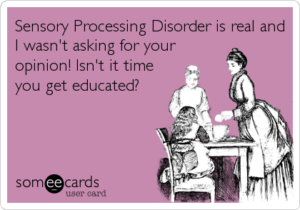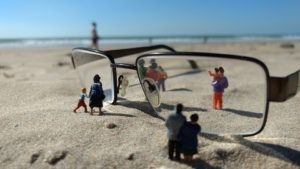“As you become multi-sensory, you begin to see yourself as a soul first and a personality second. You begin to experience yourself as more than a body and more than a mind, and the circumstances around you as meaningful and designed for your spiritual growth.” – Gary Zukav
What exactly is Sensory Integration?
Sensory Integration is the process of organizing sensory inputs, allowing the brain to produce a functional body response, however, it is essential in producing useful perceptions, emotions and thoughts.
When the brain and central nervous system are functioning in an organized, systematic manner, one is able to adequately interpret and organize the sensory information for use (Ayres, 2005). A disruption in the neural circuits which assist with neurosensory processing, may cause dysfunction in any of the sensory systems. While none of us organizes sensations perfectly, there are distinct patterns to poorly integrated systems, one of which is trauma. Trauma can be incurred as early as birth, and throughout the developmental lifespan.

Trauma vastly impacts the Sensory Systems
Trauma vastly impacts the sensory systems and may cause a disruption in the way in which the body interprets sensory input. An individual may have a variety of challenges with sensory processing and modulation of emotions and body responses, as a result of traumatic events. An individual, however, may present with sensory processing challenges without trauma. One of the hallmark changes in the autonomic nervous system is hypervigilance. This can be illustrated as up on the balls of the feet, on haunches, ready to take action, and/or an overactive Moro/starle primary reflex, or Fear Paralysis -- even when no threat is present.
Hypervigilance becomes a way to manage the excess energy resulting from the unsuccessful defense against the original threat. We use that hypervigilance to channel some of the energy into the muscles of our head, neck, and eyes in an obsessive search for danger. When combined with the internal arousal which is still present, our rational brains become irrational. The brain continues to search for external sources of danger (Levine, 1997).
“The brain’s function is to choose from the past, to diminish it, to simply it, but not to preserve it.” – Henri Bergson, The Creative Mind, 1911.
Traumatic Symptoms are not caused by the “triggering” event itself. They stem from the frozen residue of energy that has not yet been resolved and discharged. This residue remains trapped in the nervous system where it can wreak havoc on our bodies, minds and spirits (Levine, 1997). Fight, flight or freeze responses are automatic responses, which help us cope when faced with a dangerous situation. When we feel threatened (or perceived threat), these subcortical mechanisms are triggered automatically to push our bodies and minds through the experience. We may experience physiological arousal, a visceral response (i.e. suddenly feeling sick to our stomach, face flushing), muscle tension which prepares us to fight the situation or flee. When unable to move away or fight back, the response is one of freeze. The freeze response, is the point which one may become predisposed to Post-Traumatic Stress Disorder or Complex Post-Traumatic Stress Disorder. The survival patterns taken on superimpose on an individual towards heightened physiological arousal, which can remain in the body, even when the threat no longer exists.

The importance of the Sensory Systems
The body has several Sensory Systems, which allow us to experience a multitude of sensations and provide an adaptive response with a purposeful, goal-oriented response to a particular sensory experience. All of us have the following sensory systems:
Visual Processing not only encompasses stimuli we interpret through the retina, by light waves in our environment, but also to interpret fine visual details, such as reading and driving. Light sensitivity, such as bright lights or the sun may be increasingly noticeable with visual processing challenges. Additionally, visual perception issues falls under the umbrella of visual processing. Depth perception, difficulty with seeing a “whole picture”, finding landmarks in competing environments or picking out a particular item in a drawer full of objects are a few examples. Writing, drawing, going up curbs or stairs can also present as challenges when visual processing or integration, is not fully functioning.
Taste or Gustatory Sensory System provides information about the chemical makeup of particles that touch it. The four different categories of taste are sweet, sour, bitter and salty. Each are processed on different parts of the mouth and tongue. An individual can be aversive to one particular category, while craving another, such as finding bitter repulsive and craving salty or sweet foods.
The Tactile System allows us to receive information of touch, pressure, texture, heat, cold, pain and the movement of hairs on skin. The tactile system plays a vital role in both physical and mental behavior. Individuals can be aversive to unexpected touch such as another person unexpectedly touching them, or particular sensations, (i.e.as stickiness on the hands). However, on the flip side, a person can seek out touching as a way to gain perspective of one’s own body in space with putting feet in the sand, walking on the grass, deep hugs / squeezes or feeling clothing on the racks at a department store.

The Auditory system works closely with the vestibular system and is the ability to interpret sound (i.e. voice, music, filtering, etc.) The auditory input helps with planning speech. Challenges with the auditory processing can be witnessed as responding inconsistently when spoken to, misunderstanding of spoken language, difficulty localizing the direction of sounds, speaking in monotone or exceptionally loud voice (voice modulation), highly sensitive to noise, inconsistent or unexpected sounds / noise and may be overwhelmed by crowded environments where noise is exceptionally high (fairs, concerts, restaurants/bars).
Proprioception refers to sensory information gained by the contraction or stretching of muscles and by bending, straightening, pulling and compression of joints between the bones. The term comes from the Latin word “proprius”, meaning “one’s own.” Sensations from one’s own body occur during movement, however, they can also occur while standing still, due to the fact that muscles and joints constantly send information to the brain to tell us about our position (Ayres, 2005). Pushing and pulling objects, engaging in weights, yoga, walking, any type of exercise are all examples of proprioceptive input and are generally very calming for the body.
The Vestibular System is an extremely important sensory system, which often does not get the recognition it deserves. The pull of gravity generates a constant sensory flow from early fetal life until death. This helps to form a basic reference for all other sensory experiences. Movement and head position stimulates the vestibular receptors. Vestibular dysfunction may present in a variety of ways and can be under stimulated or overstimulated. Falling without an attempt to catch oneself, becoming excessively dizzy with movement or seeking excessive movement or “thrill-seeking”, difficulty with movement or smoothness of rhythm or movement, the body seems “lost in space”, and or motion sickness, including riding in a car. Rocking is a form of linear movement, such as a rocking chair and with prolonged time, will have a calming and organizing effect on the central nervous system. With gravitational insecurity, the fear of falling or feet leaving the ground poses as a real threat to the individual. Elevators and escalators can promote increased fear. Feeling insecure in wide, open places may challenge the individual to feel highly distressed or vulnerable.

The impact Trauma has on the Sensory Systems
The human body is not designed to sustain high levels of stress continuously, over a long period of time. Adverse emotional experiences and trauma, vastly impacts the brain-body connection, which means simple biological functions may begin to deteriorate with reduced performance, based on the emotional overload
Did you know the brain cannot distinguish between emotional pain and physical pain, which is often concealed as adverse emotional experiences and trauma, not yet resolved and healed. The brain connects all the body tissues, and the nervous system will adjust its physiology to fit with your congruent beliefs, which are commonly ancillary patterns taken on for surviving emotional trauma by using false beliefs, negative life patterns and unwanted core drivers. These patterns inadvertently negatively impact your body's systems and overall health and well-being. Any unresolved emotional stress, past or present, is understood to affect the nervous system in an adverse way, which may lead to physical, emotional and mental breakdown. How many of the following do you identify with?
Physical symptoms
- Physical pain or ailments, muscle tensions, joint pain
- Sleep disturbance, insomnia, nightmares
- Chronic Headaches, migraines
- Eating Disturbances / Feeding Disorders
- Gastrointestinal issues, IBS, Constipation
- Sensory Processing Deficits & sensitivities to light, vision, sound, touch, taste, movement, balance
- High blood pressure, racing heart
- Decreased immune function
- Easy startled / fight-or-flight
- Hormonal imbalances
- Fatigue, lethargy
- Balance, vertigo, dizziness
- Coordination Difficulties
Emotional Symptoms
- Depression, anxiety, stress, worry
- Shock, denial, disbelief
- Fear, panic, phobias
- Numbness, feeling disconnected
- Irritability, edginess, agitation
- Anger, mood swings, aggression
- Mood Disorders
- Feeling sad or hopeless
- Feelings of guilt, shame, blame or unworthiness
- Avoidance of people and activities
- Relationship challenges: marriage, partnerships, siblings, children, other

Cognitive Symptoms
- Distraction, difficulty starting or completing tasks -- decreased executive functioning
- Decreased concentration
- Attention Deficit Disorder, with and without hyperactivity
- Post-Traumatic Stress Disorder
- Memory lapses
- Brain fog
- Intrusive thoughts
- Confusion
- Hyper focused on a task
Behavioral Symptoms
- Compulsions and obsessions, including Obsessive-Compulsive Disorder
- Substance Abuse, addictions, vices
- Eating Disorders
- Impulsivity, reckless behavior
- Self-destructive behavior
- Disassociation
- Isolation and Social withdrawl
- Sexual disruption, intimacy issues
- Rigidity with schedules, routines and environment
- Stuck in repeated patterns of self-sabotage
- Negative experiences continues to present and repeat over and over into adulthood
Adverse emotional experiences and trauma may be impacting your health and wellness in mind-body-spirit. The positive outlook, is your past can be healed and resolved with intervention.
Trauma creates changes you don’t choose. Healing creates change you do choose.”—Michelle Rosenthal
If you'd like to join the Helix Healing Path Wellness, community, please click on the link to sign up!
References:
Ayres, A. Jane (2005). Sensory Integration and the Child. Los Angeles, CA: Western Psychological Services.
Levine, Peter A (1997). Waking the Tiger: Healing Trauma. Berkeley, CA: North Atlantic Books
© 2019 by Jodi Lawyer, M.A., OTR/L. Helix Healing Path. All rights reserved. You may quote, copy, translate and link to this article in its entirety, on free, non-donation based websites only, as long as you include the author name and a working link back to this website. All other uses are strictly prohibited.

